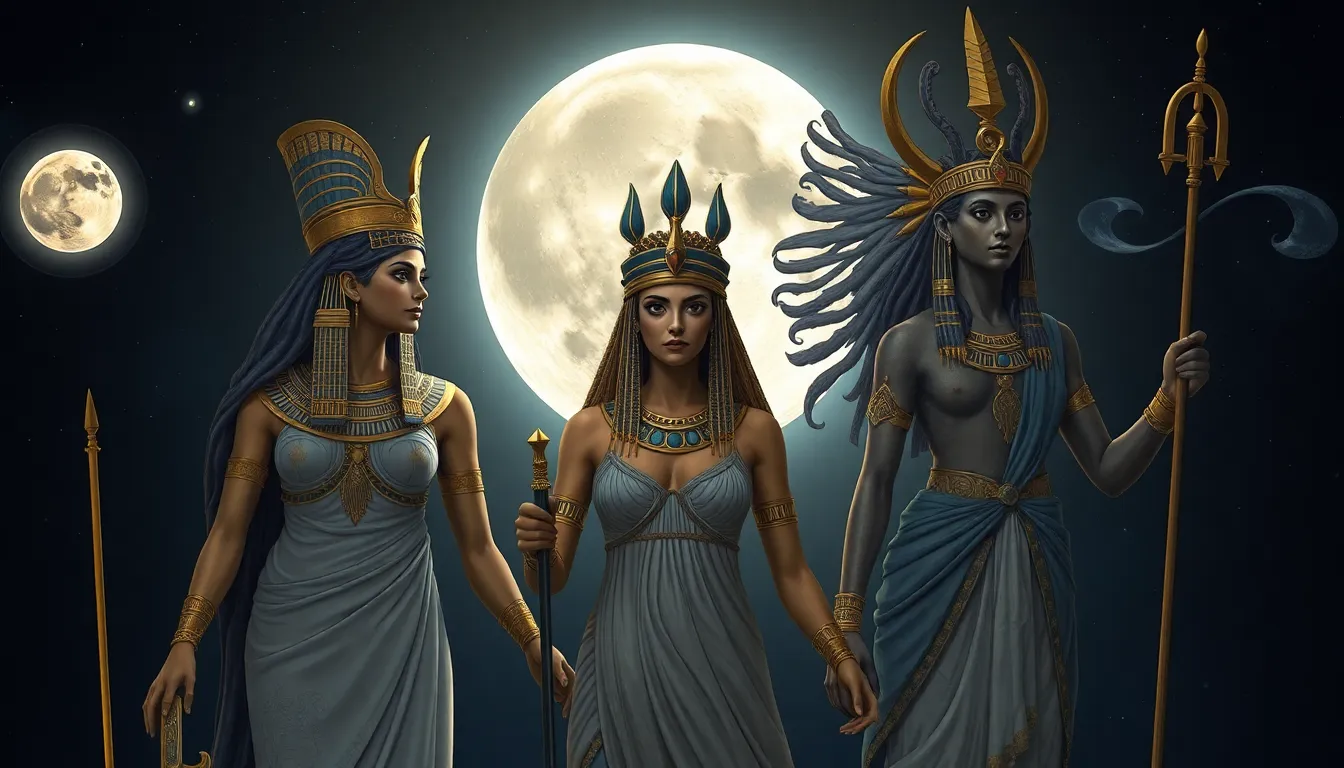The Goddesses of the Moon: From Isis to Hathor
I. Introduction
Throughout history, various cultures have revered moon goddesses, recognizing the moon’s profound influence on the natural world and human life. The moon has been a powerful symbol of femininity, fertility, and mystery, encapsulating the essence of the divine feminine. In ancient Egyptian mythology, goddesses such as Isis and Hathor exemplify these lunar qualities, embodying love, motherhood, and the cyclical nature of life.
This article explores the significance of moon goddesses, particularly in ancient Egypt, highlighting their roles, attributes, and enduring legacy within both historical and modern spiritual contexts.
II. The Significance of the Moon in Ancient Cultures
The moon has played a vital role in the mythology of various ancient cultures:
- Symbol of Femininity and Fertility: The moon’s phases mirror the cycles of women’s lives, making it a powerful symbol of fertility and feminine energy.
- Lunar Cycles and Agriculture: Ancient peoples relied on lunar cycles to guide agricultural practices, as the moon influenced tides and seasonal changes.
- Spiritual Practices: Many religious rituals were timed according to the lunar calendar, with the moon representing a gateway to the divine.
III. Isis: The Divine Mother and Lunar Goddess
Isis, one of the most revered goddesses in ancient Egypt, holds significant lunar associations.
A. Origins and Attributes of Isis
Known as the goddess of motherhood, magic, and fertility, Isis was often depicted with a throne-shaped crown and an ankh, symbolizing life. She was the wife of Osiris and the mother of Horus, embodying the archetype of the divine mother.
B. Connection Between Isis and the Moon
Isis’s connection to the moon is often illustrated through her association with the nighttime sky and her role in the cycle of life and death. The moon was seen as a reflection of her nurturing qualities, guiding the souls of the deceased through the afterlife.
C. Myths Surrounding Isis and Her Lunar Symbolism
One prominent myth involves her search for the scattered pieces of Osiris, symbolizing the moon’s role in guiding the lost and illuminating the darkness. The lunar cycles were believed to reflect her emotional journey, as the moon waxes and wanes, mirroring her resilience and nurturing spirit.
IV. Hathor: The Goddess of Love, Joy, and the Moon
Hathor is another prominent moon goddess in Egyptian mythology, representing love, beauty, joy, and motherhood.
A. Overview of Hathor’s Role in the Egyptian Pantheon
Often depicted as a cow goddess or a woman with cow horns, Hathor was worshipped across Egypt as a goddess of music, dance, and fertility. She was also associated with the afterlife, welcoming souls into the next world.
B. Hathor’s Association with the Moon and Its Phases
Hathor was linked to the moon, particularly its waxing phase, symbolizing growth, abundance, and the nurturing aspects of femininity. Her lunar associations highlight the cyclical nature of life and the importance of joy and love in every stage.
C. Cultural Depictions of Hathor and Her Lunar Aspects
Artistic representations of Hathor often showcase her as a nurturing figure, radiating warmth and love. Temples dedicated to her, such as the one at Dendera, feature intricate carvings and murals celebrating her lunar femininity and joyous spirit.
V. Other Notable Egyptian Moon Goddesses
A. Khonsu: The Youthful Lunar Deity
Khonsu, the god of the moon, is often depicted as a young man and is associated with timekeeping and healing. His lunar phases were believed to influence time and the rhythms of life.
B. Mut: The Great Mother Goddess and Her Lunar Connections
Mut, often depicted as a vulture or a woman with a crown, is another significant figure in lunar worship. As a mother goddess, she embodies protection and nurturing, paralleling the moon’s role in providing light during the night.
C. Role of Lesser-Known Goddesses in Lunar Worship
Other lesser-known goddesses, such as Seshat, the goddess of wisdom and writing, also have lunar associations, further enriching the tapestry of lunar worship in ancient Egypt.
VI. The Influence of Moon Goddesses in Ancient Religions
A. Cross-Cultural Comparisons: Moon Goddesses in Different Traditions
The reverence for moon goddesses transcended cultures. In Greek mythology, Selene is the personification of the moon, while in Hindu mythology, Chandra represents the lunar deity. Each of these goddesses embodies similar attributes of femininity and nurturing.
B. The Impact of Egyptian Moon Goddesses on Later Cultures
The worship of Egyptian moon goddesses influenced later beliefs, particularly in Greco-Roman traditions, where aspects of Isis were adopted into various mystery religions.
C. The Continuity of Lunar Worship Through History
The enduring legacy of lunar worship can be seen in various modern spiritual practices, where the moon continues to symbolize femininity and cyclical transformation.
VII. The Modern Revival of Lunar Goddess Worship
A. Contemporary Interpretations of Isis and Hathor
In modern spiritual movements, goddesses like Isis and Hathor are often celebrated for their empowering qualities, serving as archetypes for women’s spirituality and empowerment.
B. The Rise of Neo-Paganism and Goddess Spirituality
The neo-pagan movement has embraced lunar goddesses, incorporating their symbolism into rituals that honor the cycles of nature and the divine feminine.
C. Symbolism of the Moon in Modern Spiritual Practices
Today, the moon is a powerful symbol in various spiritual practices, representing intuition, the subconscious, and the cycles of life. Many practitioners align their rituals with lunar phases, celebrating the moon’s influence on personal growth and transformation.
VIII. Conclusion
The goddesses of the moon, particularly Isis and Hathor, hold a significant place in both ancient and modern spiritual traditions. Their attributes of femininity, nurturing, and cyclical change resonate deeply within the human experience, reminding us of the enduring connection between the divine feminine and the natural world.
The legacy of these lunar deities continues to inspire and inform contemporary spiritual practices, reflecting the timeless importance of lunar symbolism in understanding our lives and the universe around us.




